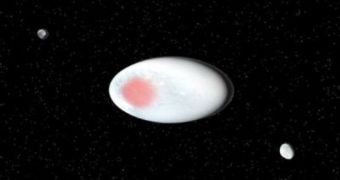A short while ago, researchers figured out that the dwarf planet Haumea is in fact covered with crystalline ice. Its two moons are covered by the same material, and astronomers now believe that interplays between gravity and radioactivity may be to blame.
In a paper published in the April issue of the journal Astronomy & Astrophysics, experts basically provide an explanation for why the object appears to glisten in space. Haumea lies beyond the orbit of Neptune.
One of the reasons for the object’s shape is the fact that it spins incredibly fast, completing one rotation around its axis in less than four hours. This makes it one of the fastest-moving objects in the solar system.
Astronomers named Haumea after the Hawaiian goddess of childbirth. Its two moons, Hi'iaka and Namaka, were named after the ancient deity’s two daughters. This system glistens in the night sky, if astronomers have large telescopes to point at them.
The dwarf planet measures about 1,200 miles (2,000 kilometers) in diameter, and is shaped like a rugby ball. In a recent study, astronomers figured out that most of the dwarf planet’s surface is covered in crystalline ice.
In fact, only 25 percent of its surface is not covered with ice. “Crystalline ice is what we all have in our fridges – the molecules of water are aligned in lattices,” expert Benoit Carry explains.
The team member holds an appointment as an astronomer at the European Space Astronomy Center (ESAC), in Madrid, Spain. The 250-mile (400-km) wide moon Hi'iaka’s surface is entirely covered with ice.
This was demonstrated by observations conducted using the Very Large Telescope (VLT), which the European Southern Observatory (ESO) operates in Chile. At this point, experts are not yet sure if the 200-kilometer-wide Namaka features a similar surface, Space reports.
“Since solar radiation constantly destroys the crystalline structure of ice on the surface, energy sources are required to keep it organized,” Carry explains. He adds that Haumea is a Kuiper Belt Object, just like Pluto, Eris, Makemake and others.
“We only know about 2,000 of these objects. Our findings provide an explanation to the presence of crystalline water ice – this provides more information on the evolution processes,” the expert concludes.

 14 DAY TRIAL //
14 DAY TRIAL //